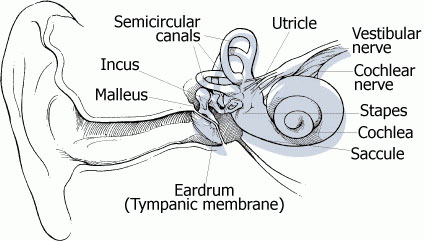-
How is the procedure performed?
Usually the procedure is performed under an inhaled anesthetic, though adults may have this done in the office with a topical anesthetic applied to the ear. If done in conjunction with other procedures (such as adenoidectomy), a deeper general anesthetic is used. A small hole is created in the eardrum and, if fluid is found, it is suctioned out of the middle ear. A small plastic tube is then placed through the hole. The procedure typically takes about 5-10 minutes.
-
Why is this procedure recommended?
The tube prevents the accumulation of fluid in the middle ear space by providing an opening into the ear canal. Usually the Eustachian tube, which connects the middle ear to the back of the nose, serves this purpose. In some people the Eustachian tube does not work well, and fluid can accumulate, causing repeated infections, hearing loss, and sometimes pain. Tube placement will hopefully reduce the frequency of ear infections. Infections that do occur with tubes in place typically have fewer symptoms, such as pain or fever.
-
How long does the tube stay in the ear?
The tube usually comes out as the eardrum attempts to heal itself. On average, this can take 6 to 18 months, though it can happen at any time after the procedure. Occasionally, the tube does not come out, and your doctor may recommend its removal. Usually if the tube has not fallen out in 2-3 years, removal should be considered. The tube may or may not be seen as it comes out, and may lie harmlessly in the ear canal, embedded in wax. Therefore, follow-up in the months after tube placement is important to determine whether the tube is still in place, assess healing of the eardrum after the tube falls out, and to see if further tube placement is needed after the tube extrudes.
-
What To Expect After Myringotomy Tube Placement. Anesthetic Recovery:
Most children recover quickly from the effects of anesthetic after tube placement. Recovery is longer if adenoidectomy or tonsillectomy were also performed, so read the instructions for these surgeries if they were done. After tube placement, children are given juice or water in the recovery room. By the time they are home, they may resume a normal diet, and can resume normal play under adult supervision. Avoid any strenuous activities or activities requiring good balance (such as climbing, swinging, bike riding, etc...) for the first 24 hours.
-
Ear Drainage:
You may initially see some discharge, which can be cloudy or even bloody. This should resolve after 2-5 days with use of the antibiotic eardrops given. If it persists, call your doctor. After the first week, ear drainage may occur if the patient develops a cold. This drainage can appear cloudy and rarely even be bloody. Most colds or nasal infections will not cause the ear to drain, as the tubes protect the ear from becoming infected. If the ears do drain, please let your doctor know so appropriate medications can be prescribed.
-
Ear Protection from Water:
If water gets into the ear canal, there is the potential for the moisture to cause an ear infection. Some physicians advise that water exposure should be completely avoided. We find that minimal clean water exposures are generally well tolerated with low risk of infection, so earplugs when bathing are not required. Children who do not swim should have few problems from playing in a pool if head submersion is avoided as much as possible, however ear plugs are the best way to avoid problems in children who actually swim and submerge the head. If the ear does become infected, it usually can be easily treated with antibiotic eardrops. If a patient is having frequent infections related to water exposure, earplugs may be recommended, but we find this is fairly uncommon.
-
Eardrops:
These usually contain an antibiotic, and sometimes a steroid. They should be instilled into the ear canal as prescribed, with the treated ear facing up. The tragus (the small bump in front of the ear canal) can be gently massaged and pressed over the ear canal to "milk" the drops down into the canal. Keep the treated ear facing up for 20-30 seconds to allow the drops to penetrate, then place a clean cotton ball in the ear. It is not necessary to keep cotton in the ear constantly; it just helps to catch any excess drops as they drain out. It is fine to clean the skin around the ear canal with hydrogen peroxide on a Q-tip or gauze, should crusted material accumulate on the skin. Never put Q-tips down in the ear canal, as injury may occur.
-
Postoperative Office Visit:
Most patients are seen 2-4 weeks after surgery to check the ears, though we are happy to see patients earlier if problems arise. Usually after this first visit, the ears are checked every 6 months until the tubes extrude. You should return earlier for problems with ear pain, hearing changes, or discharge from the ear.
-
Complications:
After the tubes extrude, we expect the eardrum to heal. There is a 3-4% chance of the eardrum not healing. These holes can be surgically repaired if necessary. Occasionally tubes may not extrude as mentioned above. It is extremely rare for the tube to fall into the middle ear, where removal is more difficult. It is also important to note that ear infections can occur even with tubes, and in rare cases the continued infection can require more intensive medical management with antibiotics.

